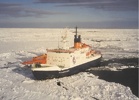 The Arctic sea ice has begun its autumn freeze after setting a new record for a summer low – a million square kilometres less than the previous record, set in 2005. The NSIDC updates are very interesting, while scientists working in the field described the summer as “remarkable
The Arctic sea ice has begun its autumn freeze after setting a new record for a summer low – a million square kilometres less than the previous record, set in 2005. The NSIDC updates are very interesting, while scientists working in the field described the summer as “remarkable
Tag: Hot
Cranky about the ETS
 Our little band of climate cranks couldn’t let an opportunity as big as the NZ Emissions Trading Scheme announcement pass by unremarked. And they didn’t. First out of the blocks was Bryan Leyland, “€œchairman of the economic panel of the New Zealand Climate Science Coalition”, pre-empting the ETS announcement to complain about the government buying offsets for ministerial travel with a press release headed “€œIs your carbon tax really necessary?”
Our little band of climate cranks couldn’t let an opportunity as big as the NZ Emissions Trading Scheme announcement pass by unremarked. And they didn’t. First out of the blocks was Bryan Leyland, “€œchairman of the economic panel of the New Zealand Climate Science Coalition”, pre-empting the ETS announcement to complain about the government buying offsets for ministerial travel with a press release headed “€œIs your carbon tax really necessary?”
“€œIf there is no evidence of man-made warming in New Zealand – and in the world – this whole charade of cap and trade, and offsetting ministerial travel emissions, should cease forthwith before any more damage is done to our internationally fragile economy.”
Leyland’s views were echoed a couple of days later by a release from Owen McShane, “€œchairman of the policy panel of the New Zealand Climate Science Coalition” (the NZ CSC appear to have enough panels to decorate a small stately home)…
ETS reactions #1
 Reaction to the emissions trading scheme (ETS) has not been slow coming in, and so far the government seems to have pulled off a remarkable balancing act, gaining at least grudging support from most quarters. Bill English was quick to say that the ETS looked “broadly sound
Reaction to the emissions trading scheme (ETS) has not been slow coming in, and so far the government seems to have pulled off a remarkable balancing act, gaining at least grudging support from most quarters. Bill English was quick to say that the ETS looked “broadly sound
NZ emissions trading scheme announced
 Details of the government’s planned emissions trading scheme (ETS) have been announced. Scoop has all the government speeches and press releases. I’m reading them at the moment, and will comment more later, but here are some highlights:
Details of the government’s planned emissions trading scheme (ETS) have been announced. Scoop has all the government speeches and press releases. I’m reading them at the moment, and will comment more later, but here are some highlights:
- Foresters will receive the full value of carbon credits on new growth (from 1/1/2008) in post-1990 forests.
- Agriculture will not be brought into the scheme until 2013.
- NZ emissions units will be Kyoto-complaint and internationally tradeable (subject to some limits).
- Some units will be allocated free, others auctioned.
- Forestry will be first into the scheme in Jan 2008.
- Transport’s next, in 2009, basically through fuel prices
- Stationery energy (power generation) and heavy industry will enter in 2010, with no free allocation for electricity generators.
- Farmers will get free allocation of units based on 90% of 2005 emissions, but details to be worked out
The government hopes that 90% of power generation will be from renewable sources by 2025. In transport, they want to cut per capita emissions in half by 2040, and encourage the wide use of electric vehicles. Goals for agriculture are more nebulous: to be the world leader in emissions reduction research, and to lead the world in agricultural emissions reductions. In forestry, they would like a net increase of 250,000ha in forest area by 2020.
The government has also released an update on our expected Kyoto deficit – up to 45.5 millions tonnes from 41.2 mT, mainly from increased dairy production. In the absence of any emissions reduction policy, the government projects this could rise to 65mT, but believes the ETS will cut the 2008-12 deficit to 25mT.
My first thought? Politically astute. By getting foresters on board with what amounts to a taxpayer subsidy, they get enough trees planted to offset a large chunk of the Kyoto liability, and buy time to bring agricultural emitters in to the scheme. More later.
More ice/less ice
 More on the Arctic melt: the National Snow and Ice Data Centre updates its commentary on this year’s record ice minimum. As of yesterday, the five day moving average of ice was still moving downwards, but slowly. Their comment on the North West Passage is interesting.
More on the Arctic melt: the National Snow and Ice Data Centre updates its commentary on this year’s record ice minimum. As of yesterday, the five day moving average of ice was still moving downwards, but slowly. Their comment on the North West Passage is interesting.
The main, deep channel of the Northwest Passage (Lancaster Sound to M’Clure Strait) has been open, or nearly ice-free, for about five weeks (since August 11, approximately). Of note is the northernmost ice edge ever recorded, at 85.5 degrees North, near the 160 degrees east longitude line.
Meanwhile, the RV Polarstern (see pic), near to completing a voyage through the Arctic as a contribution to International Polar Year, reports that large areas of this year’s ice have only been 1m thick – a 50% reduction on only 6 years ago. When the ship got close to the pole, it started raining. Ursula Schauer wrote (in early September):
A whole day of rain within 150 km of the North Pole came somewhat as a surprise! For the past few weeks, one low-pressure system after another has continuously carried warm air from northern Siberia (15°C at the Lena estuary!) towards the central Arctic Ocean. In this way the sea ice disintegrates more and more right before our eyes.
Meanwhile, I’ve bet Stoat (aka William Connolley) that 2008 will beat 2007’s record low. But only £10…
